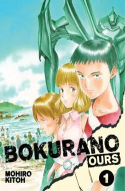 From the back cover:
From the back cover:
Nanami Momozono is alone and homeless after her dad skips town to evade his gambling debts and the debt collectors kick her out of her apartment. So when a man she’s just saved from a dog offers her his home, she jumps at the opportunity. But it turns out that his place is a shrine, and Nanami has unwittingly taken over his job as a local deity!
Nanami has all kinds of new responsibilities she doesn’t understand, dangers she’s unaware of, and a cranky ex-familiar who’s… actually pretty hot. What’s a new-fledged godling to do?
Review:
Nanami Momozono is up a creek without a paddle when her ne’er-do-well father skips town to avoid paying his gambling debts. Promptly evicted from her apartment, she has nowhere to go. It’s this that makes her accept an offer from a stranger. Saved by Nanami from a menacing (not so much) dog, a bespectacled fellow named Mikage gives Nanami a map and tells her to make use of his house, since he hasn’t been there in decades.
The map leads Nanami to a shrine and its supernatural denizens who welcome her as the next tochigami, or deity of the shrine for love and relationships. Except for Tomoe, that is. He’s Mikage’s former foxy (literally and figuratively) familiar and takes insult when Namami criticizes the state of the shrine, as he’s been doing his best to take care of it in his master’s absence. Most of the volume revolves around their contentious relationship, and though Tomoe claims that he doesn’t care if Nanami should get deceived and devoured by other creatures, he still comes to her aid when called.
It’s an intriguing setup so far, with Nanami seemingly poised to leave the human world behind (school, etc.) and devote herself to the shrine and to granting the prayers of the few remaining worshippers. She’s overwhelmed by the amount of work at first but is so grateful for room and board she’s willing to do just about anything. Although Tomoe is generally contemptuous of her, once forced into an agreement to serve as her familiar, he decides to make her into a kami whom it will not be a humiliation to serve.
This results in a few scenes of Nanami attempting to perform magic and failing, while Tomoe insults her (though she does overhear him defending her later). At one point he calls Nanami a fool for interrupting a meeting he’d told her to stay out of, and we get this voiceover from her:
Contrary to what he said, Tomoe’s hand is tenderly, firmly holding mine.
Now, obviously this is a lot less worrisome than the “I’m an asshole because I care” dynamic in another Shojo Beat series, Black Bird, but it still made me think of Black Bird, which is never a good sign. Perhaps Tomoe will stop being such a git once Nanami proves herself, but I am a little concerned.
Ultimately, I’m looking forward to see how this series develops but so far, I think I prefer Suzuki’s Karakuri Odette, which, coincidentally, is the Manga Moveable Feast pick for January! Visit Manga Report for more information.
Kamisama Kiss is published in English by VIZ. The series is ongoing in Japan and is currently up to eight volumes.










 Fifteen kids—most of them, except for one boy’s kid sister, in 7th grade—are taking part in a summer program called “Seaside Friendship and Nature School.” Chafing at the instruction to go out and observe nature, the kids decide to explore a nearby cave, where they inexplicably discover a computer lab and a strange guy who calls himself Kokopelli.
Fifteen kids—most of them, except for one boy’s kid sister, in 7th grade—are taking part in a summer program called “Seaside Friendship and Nature School.” Chafing at the instruction to go out and observe nature, the kids decide to explore a nearby cave, where they inexplicably discover a computer lab and a strange guy who calls himself Kokopelli. Bokurano is structured similarly, focusing on each pilot as he or she “gets the call.” There are merits and flaws to this approach: obviously, the current pilot receives a lot of attention, and it’s interesting to see how each approaches the responsibility differently. One boy cares nothing for human casualties while another carefully takes the battle out into the harbor to minimize damage. One girl uses her final hours to sew morale-boosting uniforms for the group. Unfortunately, this also means that at any given time there are about a dozen characters relegated to the background, waiting for their turn to contribute to the story.
Bokurano is structured similarly, focusing on each pilot as he or she “gets the call.” There are merits and flaws to this approach: obviously, the current pilot receives a lot of attention, and it’s interesting to see how each approaches the responsibility differently. One boy cares nothing for human casualties while another carefully takes the battle out into the harbor to minimize damage. One girl uses her final hours to sew morale-boosting uniforms for the group. Unfortunately, this also means that at any given time there are about a dozen characters relegated to the background, waiting for their turn to contribute to the story.




Recent Comments